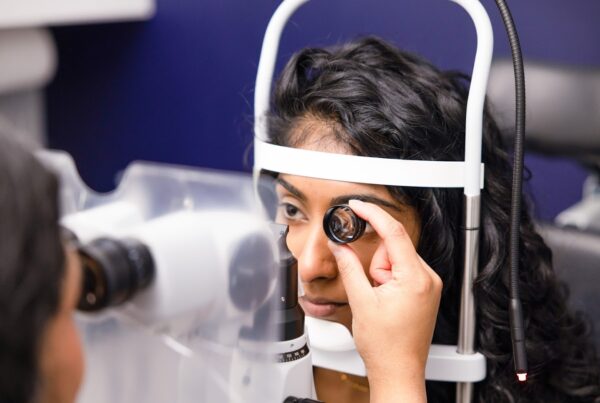In this fast-paced digital age, digital screens are everywhere, creating new challenges for our eye health. If you’ve ever experienced the discomfort of eye fatigue, persistent headaches, or dry eyes after a day spent in front of screens, you’re not alone. Digital eye strain has become a prevalent concern in the modern world, and addressing it is crucial for maintaining optimal eye health.
At Durham Vision Care, we understand the impact that prolonged screen time can have on your eyes, and we’re here to guide you through practical strategies to protect your vision in today’s digital world. In this blog post, we’ll delve into the nuances of digital eye strain, explore its causes, and provide practical tips to alleviate and prevent its effects.
So, whether you’re a dedicated professional clocking hours on a computer, a student immersed in online studies, or simply someone who enjoys spending time online, here are some actionable steps to keep your eyes comfortable, refreshed, and healthy.
Understanding Digital Eye Strain
Digital eye strain, also known as computer vision syndrome, is a prevalent condition in our technology-driven era. It manifests as a collection of discomfort and visual disturbances that arise from extended periods of staring at digital screens, such as computers, smartphones, and tablets.
Imagine your eyes as delicate instruments constantly adapting to the demands of the digital landscape. Prolonged exposure to screens can lead to various symptoms. You might find yourself experiencing persistent headaches, dry eyes, blurred vision, and general discomfort, as reduced blinking during screen time contributes to insufficient moisture.
Causes of Digital Eye Strain
In our constantly connected world, the causes of digital eye strain are multifaceted, each stemming from the pervasive use of digital devices. Prolonged screen time stands as a primary culprit, as our eyes work tirelessly to adjust to the artificial demands of screens. The blue light emitted by screens may further exacerbate the strain, disrupting our natural sleep-wake cycles and contributing to eye discomfort. Incorrect screen positioning can also play a significant role. An improperly positioned screen can force our eyes into unnatural angles, increasing tension and fatigue. Equally impactful is the often-overlooked factor of breaks during screen use. In our quest for productivity, we sometimes forget to give our eyes some much-needed rest.
Together, these four factors can cause significant strain and discomfort to your eyes throughout the day. Fortunately, you can use a handful of simple tactics to ensure you get the most out of your screen time while also protecting your eyes.
How to Prevent Digital Eye Strain
Follow the 20-20-20 Rule: Refresh Your Vision
One effective strategy to alleviate digital eye strain is adhering to the 20-20-20 rule. This rule recommends taking a 20-second break to look at something 20 feet away every 20 minutes of screen time. This simple practice helps reduce eye fatigue and strain by providing moments of respite for your eyes. This routine allows the eye muscles to relax and refocus, mitigating the cumulative effects of prolonged screen use.
Adjust Screen Settings: Optimize Your Visual Environment
Fine-tuning your screen settings can make a substantial difference in alleviating digital eye strain. Consider reducing blue light emissions by enabling the blue light filter on your devices, especially during evening hours when exposure to blue light can interfere with sleep patterns. Additionally, optimizing screen brightness to match your surroundings can enhance visual comfort and minimize the strain caused by glaring screens.
Proper Screen Positioning: Find Your Ideal Viewing Angle
Screen positioning plays a pivotal role in reducing eye strain. Ensure your screen is positioned at eye level to maintain a comfortable viewing angle. This prevents unnecessary strain on neck and shoulder muscles, enhancing overall posture and minimizing the risk of long-term discomfort. Position your screen at a distance that allows for a relaxed focus, striking a balance between clarity and visual comfort.
Blink Regularly: Nourish Your Eyes Naturally
Blinking tends to decrease when using screens, leading to dry eyes and discomfort. Remind yourself to blink regularly, as this natural action helps distribute tears evenly and prevents the eyes from drying out. Conscious blinking maintains adequate moisture and contributes to a refreshed and lubricated ocular surface.
Take Regular Breaks: Embrace Moments of Relief
Integrating breaks into your screen time is crucial for reducing digital eye strain. During breaks, engage in activities that promote relaxation and eye rejuvenation. Consider practicing the 20-20-20 rule mentioned earlier, or take a brief stroll to allow your eyes to focus on objects at varying distances. These breaks allow your eyes to rest, ensuring sustained comfort and minimizing the risk of prolonged strain.
Blue Light Glasses and Protective Measures
Blue light, emitted by digital screens, has become a focal point in discussions about eye health in the digital age. As an integral part of the visible light spectrum, blue light has short wavelengths and higher energy, making it capable of penetrating deep into the eyes. Many individuals turn to blue light-blocking glasses to counteract the potential adverse effects of prolonged exposure. These specialized eyeglasses feature lenses that filter out a portion of blue light, reducing its penetration into the eyes. By doing so, they aim to alleviate eye strain, minimize disruptions to circadian rhythms, and promote more comfortable screen use.
In addition to blue light glasses, adopting other protective measures against blue light exposure is essential. Screen filters, available as physical overlays or software applications, can be applied to devices to reduce the amount of blue light emitted. Some electronic devices also offer built-in settings that allow users to adjust the colour temperature, limiting the emission of blue light during specific hours. Establishing a digital curfew, where screen time is minimized before bedtime, can further support a healthy sleep-wake cycle by mitigating the impact of blue light on melatonin production.
Keeping Your Eyes Healthy for Years to Come
Recognizing the pivotal role of regular eye check-ups is fundamental in safeguarding your vision, especially in the context of digital eye strain. Optometrists play a crucial role in detecting issues related to digital eye strain and tailoring solutions to address them effectively. Through comprehensive eye examinations, optometrists can identify early signs of strain, prescribe corrective lenses or recommend specialized treatments, and offer personalized advice on mitigating the impact of extended screen time.
At Durham Vision Care, we understand the unique challenges posed by the digital age. If you live near Oshawa and are looking for an eye doctor near you, prioritize your eye health and schedule an eye examination with our dedicated team of professionals. Your eyes deserve the attentive care and expertise our optometrists bring, ensuring you navigate the digital landscape with clarity and comfort. Don’t wait for symptoms to escalate—take the proactive step towards optimal eye health with a visit to Durham Vision Care.










Recent Comments